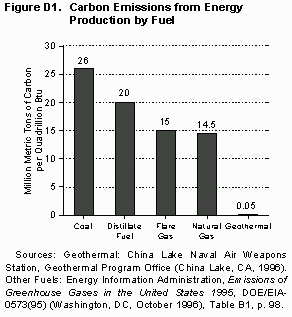
Although the elimination of rare geological formations, such as geysers, runs counter to today’s attitudes on environmental preservation, atmospherically, geothermal is a “green” renewable energy resource (Figure D1). Compliance with environmental regulations and legislation throughout the total fuel cycle for geothermal electricity generation facilities is attained with relative ease, due primarily to the minimal emissions from their closed systems.
 |
In the United States in 1994, electric utilities accounted for 35 percent of the carbon dioxide emissions from fossil energy consumption [259] and almost 10 percent of the total [260], 66 percent of the nitrous oxide emissions from stationary sources [261], 70 percent of U.S. sulfur dioxide emissions (the main cause of acidic precipitation), 33 percent of our nitrogen oxide emissions (which induce formation of ground-level ozone), and 20 percent of the anthropogenic releases of gases linked to the atmospheric greenhouse effect.
Development of geothermal energy has a minimal negative impact on the environment compared with development associated with conventional energy sources. Geothermal power plants have sulfur emissions rates that average only a few percent of those from fossil fuel alternatives. The newest generation of geothermal power plants emits only 0.3 pounds of carbon dioxide per megawatthour of electricity generated. Similarly, there are no combustion byproducts (i.e., nitrogen oxide emissions) [262].
In addition, geothermal power plants require relatively little land, taking up only a fraction of that needed by other energy sources. Other land uses can mingle with geothermal plants with little interference or fear of accidents. Geothermal facilities have neither huge piles of ash, nor slag, nor bags of radiation-tainted sulfur to contend with. Containment barriers associated with most fossil-fueled power plants are nonexistent in current designs.
Destruction of rare geyser activity as a result of changing the water levels has proven to be an environmental liability. Electricity generation from geothermal resources has ended the eruptions from the second- and third-largest geyser fields in the 50 States. By 1987, the Beowawe Geyser Field in central Nevada and the Steamboat Springs geyser field, located several miles south of Reno, Nevada, no longer supported geyser activity [263, 264]. No efforts are underway to stabilize the fields or restart the geysers.
Geothermal resources contribute to energy supplies through both electrical power generation and direct heat uses, and to reduced energy demand through savings in electricity and natural gas that result from the use of geothermal heat pumps to heat and cool buildings. Greenhouse gas emissions are almost zero; ozone-depleting chemicals from both direct and indirect sources are also almost zero; sulfur oxide emissions are virtually zero because, by design, geothermal’s modern closed-cycle systems reinject almost everything but the extracted heat; and geothermal facilities present light demands on land use, looking much like any light industry facility.
Renewable Energy
Annual 1996
April 1997
[Click on any entry to go there.]